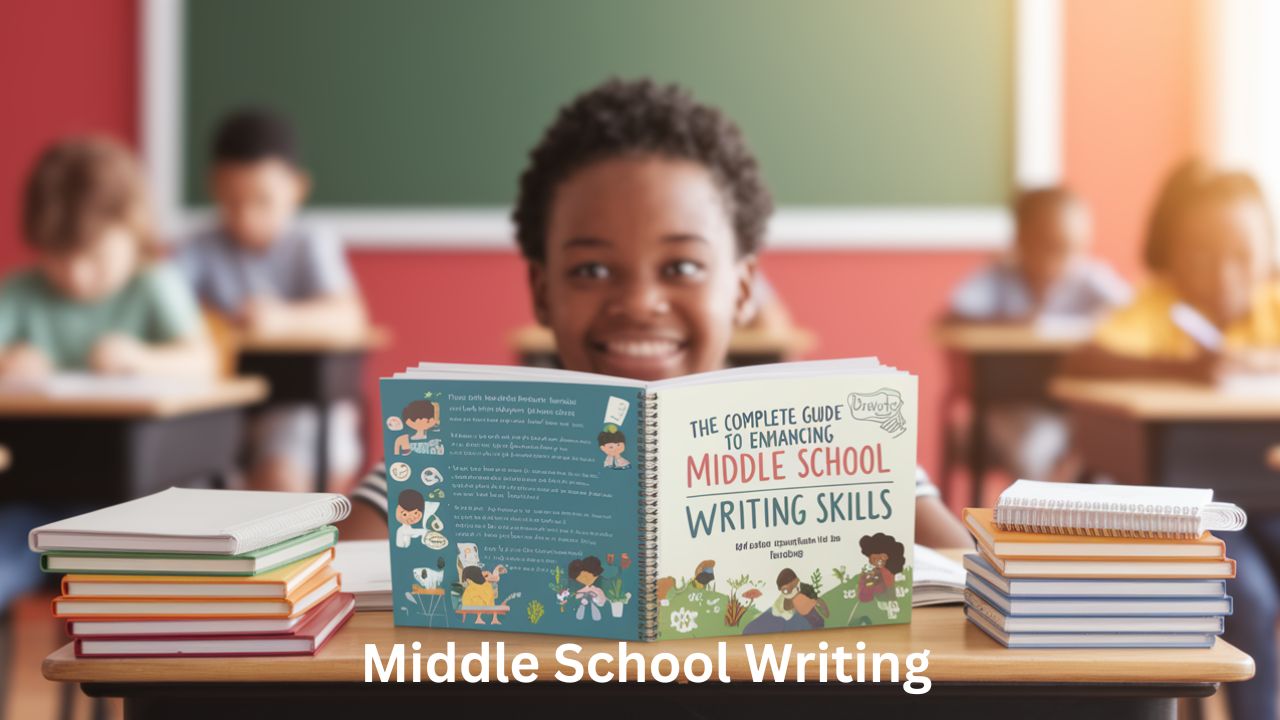
Middle School Writing
Middle school writing plays a crucial role in shaping academic success. It builds the bridge between basic literacy and high-level communication. When students enter this stage, they face new challenges. These include writing longer essays, using critical thinking, and organizing complex ideas. Teachers and parents must support students during this important transition.
In this guide, you will learn effective strategies to enhance middle school writing skills. We’ll explore how to teach structure, encourage creativity, and develop voice. Additionally, you’ll find ways to make writing fun and purposeful for all learners. This article provides classroom-ready tools, tips, and activities that lead to real results.
Why Writing Skills Matter in Middle School
Strong writing skills empower students academically and socially. Writing helps them express thoughts clearly and persuasively. Furthermore, it strengthens reading, vocabulary, and overall communication. When middle schoolers write well, they perform better across all subjects.
Students also need writing to thrive in high school and college. Therefore, educators must prioritize consistent practice, feedback, and encouragement. Writing connects learning to the real world, boosting both confidence and comprehension.
Understanding the Developmental Stage of Middle School Writers
Middle schoolers face rapid cognitive and emotional changes. Their thinking grows abstract, and their identity begins forming. Because of this, writing assignments should match both academic ability and emotional development.
At this stage, students:
-
Crave independence but still need structure.
-
Want their voices heard through writing.
-
Respond well to topics that relate to their lives.
Support must balance challenge and safety. Provide clear expectations while encouraging creativity and risk-taking. When students feel supported, their writing flourishes.
Creating a Writing-Positive Classroom Environment
First, establish a writing culture built on trust and encouragement. Students must feel safe to explore ideas without fear of judgment. Promote peer collaboration, group brainstorming, and writing circles.
Here’s how to build the right atmosphere:
-
Celebrate effort, not just grammar.
-
Post inspiring student writing on classroom walls.
-
Use writing journals for daily practice and free writing.
-
Share your own writing to model vulnerability and technique.
Motivation begins with environment. Foster curiosity and creativity by valuing every student’s voice.
Teaching the Writing Process: Step-by-Step Guidance
Break down the writing process into clear steps. Many students struggle because they don’t know where to begin or how to revise.
Teach this five-step approach:
-
Prewriting – Brainstorming, researching, and outlining ideas before writing.
-
Drafting – Writing the first version with focus on ideas, not grammar.
-
Revising – Adding details, reorganizing paragraphs, and improving content clarity.
-
Editing – Fixing grammar, punctuation, and spelling errors.
-
Publishing – Sharing the final version through presentations or class books.
Repeat the process regularly until it becomes natural. Over time, students develop writing confidence and independence.
Incorporating Graphic Organizers and Writing Templates
Visual tools help students structure thoughts and plan essays. Use graphic organizers for every stage of writing.
Some popular choices include:
-
Venn diagrams for compare-and-contrast essays.
-
Story maps for narrative writing.
-
Idea webs for brainstorming.
-
Paragraph planners with topic and detail boxes.
Templates offer scaffolding that builds independence. Eventually, students will write freely without needing them.
Improving Sentence Variety and Paragraph Structure
Monotonous writing makes essays boring. Teach students to vary sentence types and length for better flow. Introduce them to:
-
Compound and complex sentences.
-
Transition words for smooth paragraph shifts.
-
Sensory language for descriptive writing.
-
Hooks and clinchers for powerful opening and closing lines.
Encourage students to mix short and long sentences. This keeps the reader engaged and strengthens pacing.
Building Vocabulary Through Writing Activities
Rich vocabulary elevates writing. Students often rely on repetitive or vague words. That’s why direct instruction matters.
Try these activities:
-
Word walls with vivid verbs and adjectives.
-
“Dead word” replacements for overused terms like “nice” or “good.”
-
Weekly vocabulary journals with sentence practice.
-
Themed writing prompts using specific word banks.
Show students how strong word choice shapes meaning and tone. When vocabulary improves, writing becomes sharper and more impactful.
Using Mentor Texts to Teach Style and Voice
Mentor texts are published works that model excellent writing. Use them to teach tone, figurative language, and structure.
Choose mentor texts based on genre:
-
Personal essays to teach voice and emotion.
-
News articles for informational structure.
-
Short stories to explore character development.
Read texts aloud and analyze them together. Ask students: What works? Why is this sentence powerful? Can you try it too?
Modeling fosters skill transfer. Students learn to mimic techniques and adapt them to their own writing.
Encouraging Journaling and Freewriting
Daily writing improves fluency and confidence. Journals and freewriting offer low-stress spaces to experiment with ideas.
Here’s how to integrate journaling:
-
Start each class with a five-minute journal entry.
-
Offer prompts that relate to current events or personal reflections.
-
Encourage students to write without stopping or self-editing.
-
Review journals periodically for effort, not grammar.
Journaling helps students find their voice. It turns writing from a task into a personal experience.
Teaching Genre-Specific Writing Skills
Middle school writing should include multiple genres. Each one teaches different techniques and requires different thinking.
Focus on these core genres:
-
Narrative Writing – Teaches storytelling, sequencing, and emotional expression.
-
Expository Writing – Focuses on explanation and clarity.
-
Persuasive Writing – Builds argument skills and critical thinking.
-
Descriptive Writing – Enhances creativity and sensory language.
Rotate genres throughout the year. Let students compare styles and discover their strengths.
Peer Review and Collaborative Writing Projects
Students learn from one another. Peer feedback helps them view writing through a reader’s lens. Use structured peer review sessions.
Teach students to:
-
Give specific compliments and constructive feedback.
-
Ask clarifying questions instead of making demands.
-
Use checklists to evaluate structure, clarity, and grammar.
Group writing projects also foster collaboration. For example, co-write a class magazine, storybook, or blog.
Implementing Technology in Writing Instruction
Digital tools engage students and streamline the writing process. Use platforms that support drafting, collaboration, and publishing.
Great tools include:
-
Google Docs for real-time editing and feedback.
-
Grammarly for grammar checks and suggestions.
-
Storybird or Book Creator for creative writing.
-
Padlet or blogs for publishing student work.
When students see their writing shared publicly, they write with more purpose and pride.
Using Rubrics to Guide and Grade Writing
Rubrics clarify expectations and improve grading consistency. Share rubrics with students before writing begins.
Include clear criteria for:
-
Organization and structure.
-
Grammar and mechanics.
-
Ideas and content development.
-
Creativity and originality.
Involve students in creating or modifying rubrics. This promotes ownership and deeper understanding.
Celebrating Student Writing
Recognition boosts motivation. Celebrate milestones and showcase writing publicly.
Ideas include:
-
Monthly “Author of the Month” awards.
-
Writing contests with fun prizes.
-
Class anthologies or newsletters.
-
Parent nights featuring student readings.
When students feel their writing matters, they work harder and take pride in their progress.
Providing Timely and Constructive Feedback
Feedback guides growth. Focus on strengths first, then offer one or two areas for improvement. Avoid overwhelming criticism.
Use one-on-one conferences to personalize feedback. Written comments should be specific and actionable.
Offer sentence starters like:
-
“You did a great job using sensory detail here…”
-
“Try expanding this idea to show more emotion…”
Timely feedback turns writing into a learning journey, not just a graded task.
Dealing with Writing Resistance and Anxiety
Some students dislike writing because of past failure or fear. Address anxiety with patience and positive reinforcement.
Strategies include:
-
Breaking tasks into smaller steps.
-
Using graphic organizers for planning.
-
Offering choice in topics or formats.
-
Allowing oral storytelling before writing.
With time, students build confidence. Celebrate small wins and always encourage progress over perfection.
Incorporating Writing Across the Curriculum
Writing doesn’t belong only in English class. Use writing in science, history, and math to deepen understanding.
Ideas include:
-
Science journals explaining experiments.
-
History essays analyzing events or characters.
-
Math reflections describing problem-solving steps.
Cross-curricular writing reinforces skills and shows real-world application. It also boosts writing volume without overloading language teachers.
FAQs: Middle School Writing
1. How can I help my middle schooler improve writing at home?
Encourage daily journaling, offer feedback on homework, and discuss books or articles together to build critical thinking.
2. What are common writing struggles for middle schoolers?
Many struggle with organization, grammar, idea development, and writing fluency. Practice and structure help address these issues.
3. Should middle schoolers use digital tools for writing?
Yes. Tools like Google Docs and Grammarly can support editing, collaboration, and publishing when used responsibly.
4. How often should students write in middle school?
Daily writing, even for a few minutes, improves fluency and builds confidence over time.
5. How do I make writing fun for middle schoolers?
Use games, story starters, creative prompts, and real-world projects. Celebrate effort and creativity consistently.
6. What genres should be taught in middle school?
Focus on narrative, persuasive, expository, and descriptive writing. Rotate regularly to build diverse writing skills.
Summary: Empowering Middle Schoolers Through Writing
Middle school writing develops more than academic skills—it nurtures self-expression, confidence, and lifelong communication. With the right support and structure, students transform into strong writers who love the process.
Use strategies like modeling, journaling, and feedback to inspire growth. Encourage experimentation and praise progress. Writing may challenge students, but with patience and consistency, it becomes a joyful, empowering experience.
Let’s commit to equipping every middle schooler with the tools they need to write with clarity, purpose, and heart.







